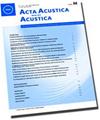Effects of a Synthetic Clarinet Bore Liner on Spectral Centroid and Fundamental Frequency Error
Q1 Arts and Humanities
引用次数: 0
Abstract
Throughout their relatively short history, various materials have been used to construct clarinets. While wood is the most common material used for modern professional clarinets, other materials have been and continue to be used, including synthetic materials. Despite the availability and accessibility of these materials, professional musicians rarely use instruments made from synthetics, insisting that their wooden counterparts produce superior results. Numerous studies have found the energy radiated directly by rigid cylindrical vibrating tubes to be both insignificant and have little to no effect on an internal vibrating air column. Using real instruments played by musicians, the present study compared a prototype clarinet upper joint with a synthetic bore liner produced by French instrument maker Henri Selmer Paris to two unlined, solid wood clarinets of the same make and model by examining two acoustical parameters. Spectral centroid and fundamental frequency f0 pitch error were measured for 45 notes (written E3-C7), performed by five accomplished clarinetists unaware of which instrument they were playing. Consistent with findings from other researchers, the particular instrument had no significant effect on spectral centroid. Meanwhile, although a significant effect of the instrument on f0 pitch error was found, pairwise comparisons suggest non-significant effects from the lined joint.合成单簧管内径衬里对谱质心和基频误差的影响
在单簧管相对较短的历史中,各种材料被用来制造单簧管。虽然木材是现代专业单簧管最常用的材料,但其他材料已经并将继续使用,包括合成材料。尽管这些材料的可用性和可获得性,专业音乐家很少使用由合成材料制成的乐器,坚持认为他们的木制同行产生更好的效果。大量研究发现,刚性圆柱振动管直接辐射的能量微不足道,对内部振动气柱几乎没有影响。本研究使用音乐家演奏的真实乐器,通过检查两个声学参数,将法国乐器制造商Henri Selmer Paris生产的带有合成内胆的单簧管原型上接头与两个相同品牌和型号的无衬里实木单簧管进行了比较。谱质心和基频0音高误差测量了45个音符(写E3-C7),由五位熟练的单簧管演奏家演奏,他们不知道自己在演奏什么乐器。与其他研究人员的发现一致,特殊仪器对光谱质心没有显著影响。同时,虽然发现仪器对0节距误差有显著影响,但两两比较表明衬里关节的影响不显著。
本文章由计算机程序翻译,如有差异,请以英文原文为准。
求助全文
约1分钟内获得全文
求助全文
来源期刊
CiteScore
2.60
自引率
0.00%
发文量
0
审稿时长
6.8 months
期刊介绍:
Cessation. Acta Acustica united with Acustica (Acta Acust united Ac), was published together with the European Acoustics Association (EAA). It was an international, peer-reviewed journal on acoustics. It published original articles on all subjects in the field of acoustics, such as
• General Linear Acoustics, • Nonlinear Acoustics, Macrosonics, • Aeroacoustics, • Atmospheric Sound, • Underwater Sound, • Ultrasonics, • Physical Acoustics, • Structural Acoustics, • Noise Control, • Active Control, • Environmental Noise, • Building Acoustics, • Room Acoustics, • Acoustic Materials and Metamaterials, • Audio Signal Processing and Transducers, • Computational and Numerical Acoustics, • Hearing, Audiology and Psychoacoustics, • Speech,
• Musical Acoustics, • Virtual Acoustics, • Auditory Quality of Systems, • Animal Bioacoustics, • History of Acoustics.

 求助内容:
求助内容: 应助结果提醒方式:
应助结果提醒方式:


